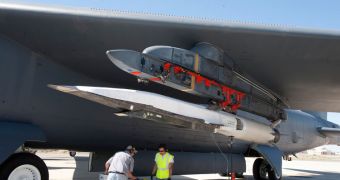In a recent test conducted by the US Air Force on the X-51 Waverider, the hypersonic-capable, scramjet engine-driven vehicle did not ignite in mid-air, essentially failing one of its most important tests.
The USAF has been trying to build a working scramjet engine for years, and the X-51 vehicle was its most promising lead thus far. Past test flights carried out with the machine were successful, and no one was expecting the machine to fail during its latest one.
The experimental aircraft flew its latest mission on June 13. It was accelerated via rocket to Mach 5, or about five times the speed of sound. At these velocities, the scramjet engine should have kicked in, and make the aircraft go even faster.
However, while the initial stages of the test were successful, and the engine did ignite, engineers' happiness was short-lived. After burning on ethylene fuel for a short while, the motor did not switch to its primary JP7 fuel, as planner.
In other words, the vehicle failed to reach full power, which is what is expected of a scramjet engine. The whole idea of hypersonic flight is to exceed the speed of sound as many times over as possible.
Scramjet engines have a fairly simple propulsion system, but which is extremely difficult to create in practice. Aircrafts employing them are generally designed in such a manner that they are able to make their own shock waves go directly into their engine's inlets.
In other words, they no longer actively absorb air into the combustion chamber, but rather “model” it in through their shape. This allows scramjet aircraft to reach speeds of up to Mach 15, and to go as high as the edge of space, where the atmosphere ends.
This type of “breathing propulsion” also holds great promise for promoting the field of space exploration. Most experts agree that relying on chemical fuels such as liquid hydrogen and liquid oxygen for rocket launches will not always be possible.
The goal of scramjet efforts “is to enable the ability to get to space, return to Earth, then get back to space with an aircraft-like operations tempo,” reads the Hypersonic Roadmap, a formal strategy of the Pentagon.
“Obviously we're disappointed and expected better results, but we are very pleased with the data collected on this flight,” a statement from USAF Research Laboratory's X-51A program manager, Charlie Brink, reads.
This was the Waverider's second free-flight test. It was deployed from aboard a B-52 Stratofortress long-range bomber, which was flying at an altitude of about 50,000 feet (15,240 meters).
“We will continue to examine the data to learn even more about this new technology. Every time we test this new and exciting technology, we get that much closer to success,” Brink adds, quoted by Space.

 14 DAY TRIAL //
14 DAY TRIAL //